After spending the first two episodes of this season separated — by both time and space — Michael Burnham finally reunites with the Discovery crew in “People of Earth,” setting up their mission for the season: find the Federation and unravel the mystery of The Burn.
Building off a clue discovered by Burnham during her yeah alone in the 31st century, Discovery heads for Earth, hoping to find the voice behind a 12-year-old Starfleet transmission… but the Earth they find is not the Earth they left. It remains a paradise, but one that has closed itself off from the rest of the galaxy.
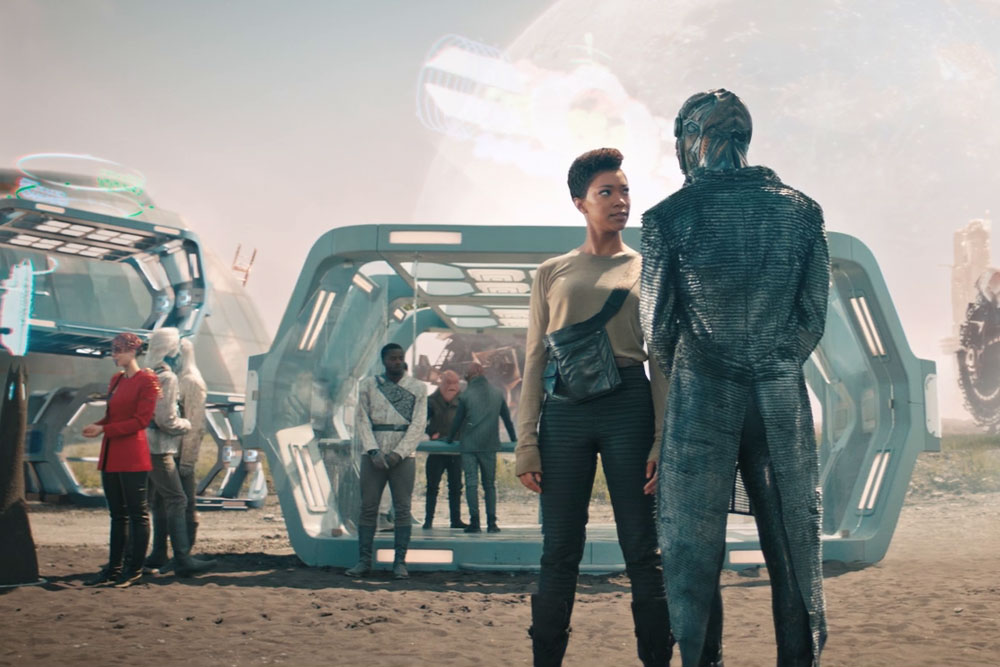
Upon arriving to what they thought was the head of Starfleet and Federation operations, the Discovery is confronted instead by the United Earth Defense Force, and their representative Captain Ndoye (Phumzile Sitole). Following The Burn, Federation Headquarters was relocated away from Earth, and the planet rebuilt itself to be a self-sufficient stronghold, one that has grown hostile to outsiders, a consequence of near constant attacks by dilithium raiders.
After the Discovery helps Earth manage their way through a raider attack, it is revealed that far from the evil pirates United Earth believed its enemies to be, they are in fact desperate people from a research colony on Saturn’s moon, Titan. With the help of Book and his ship, Discovery mediates a truce between Ndyoa and the leader of the raiders, Wen (Christopher Heyerdahl).
Meanwhile, we are introduced to Adira (Blue del Barrio), one of the United Earth inspectors under Ndoye’s purview who immediately suspects that there’s more to Discovery than meets the eye. After earning the trust of Paul Stamets (Anthony Rapp), they reveal that the message-sending Admiral Senna Tal lives on… in the form of the Trill symbiont inside Adira.
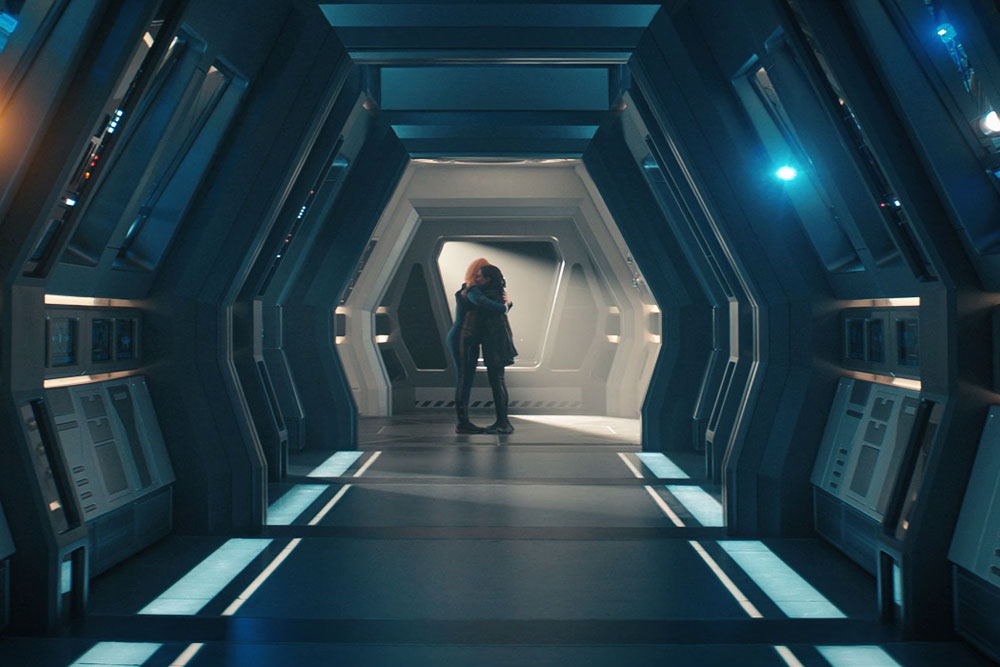
Written by veteran Discovery scribes Bo Yeon Kim and Erika Lippoldt, and directed by Jonathan Frakes, “People of Earth” is an episode of reunions and introductions. Burnham’s reunion with the Discovery is a bittersweet one, as she has changed a lot in the year away from the ship, and the 18-month gap between between Discovery seasons (thanks to the pandemic’s impact on post-production) really helps reinforce the emotion in these scenes.
Despite the growth in the Burnham character — some of which is only hinted at and we expect will be explored more in upcoming episodes — and the introduction of new characters that will inevitably alter the chemistry of the show’s cast, some things never change. Michael Burnham (Sonequa Martin-Green) and Sylvia Tilly’s (Mary Wiseman) relationship remains as sweet as ever…. and Burnham and Saru’s relationship remains as complicated as ever.
After being teased in the trailers leading up to this season, “People of Earth” finally allows Saru (Doug Jones) to drop the ‘acting’ tag and officially names the mild-mannered Kelpien the new captain of the starship Discovery. Burnham’s willingness to back away from the big chair, as well as her inability to bring Saru completely into her thinking as she executes a daring plan that puts Discovery’s dilithium at risk, makes Saru suspicious of her.
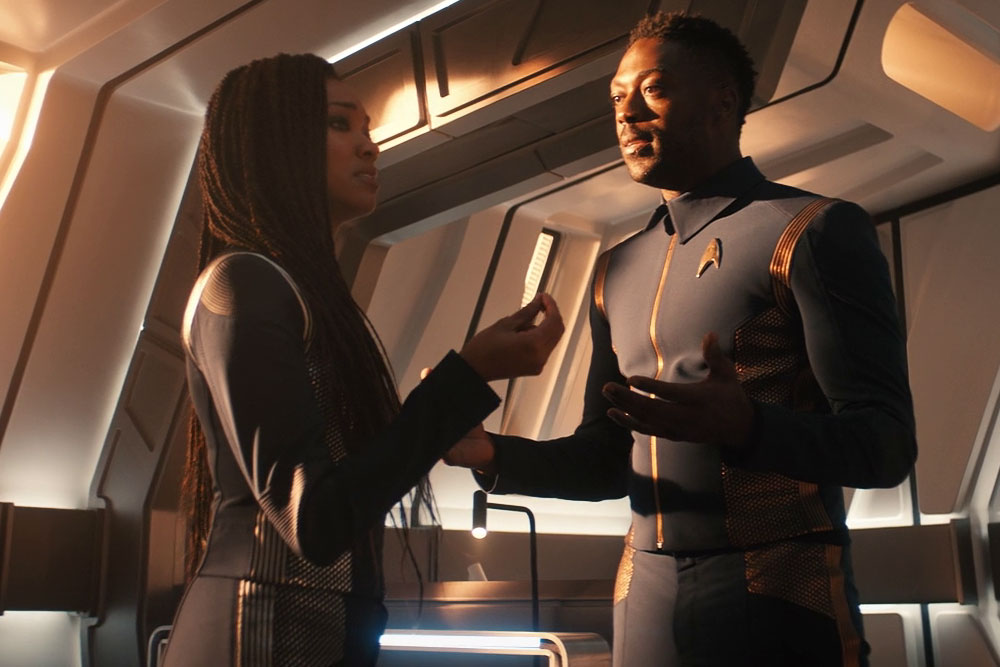
Though the now-Captain Saru wants Burnham to be his first officer, trust issues remain between these two characters. The Burnham-Saru scene in Saru’s new ready room, where he is installing the late Captain Georgiou’s prized telescope (last seen in Season 1’s “Choose Your Pain”), shows that the two characters have come a long way, but they have not yet entirely resolved their issues.
As for the new characters, Adira makes a good first impression, and appears to fit in well quickly with the show’s cast (despite initial friction with Tilly). We knew from the first Season 3 trailer that we would be meeting the Trill this year, and it appears we now know a little about how that will happen — as the human Adira carries a Trill symbiont who may hold the key to Discovery finding whatever remains of the Federation.
I am excited for this exploration of elements of Deep Space Nine, and having a Trill character will provide a nice link between Discovery’s crew and the galaxy they find themselves in, as the Tal symbiont may have memories stretching back to the 23rd century — and calls back to the very first appearance of the Trill species, “The Host,” where Will Riker carried a symbiont for a short time.
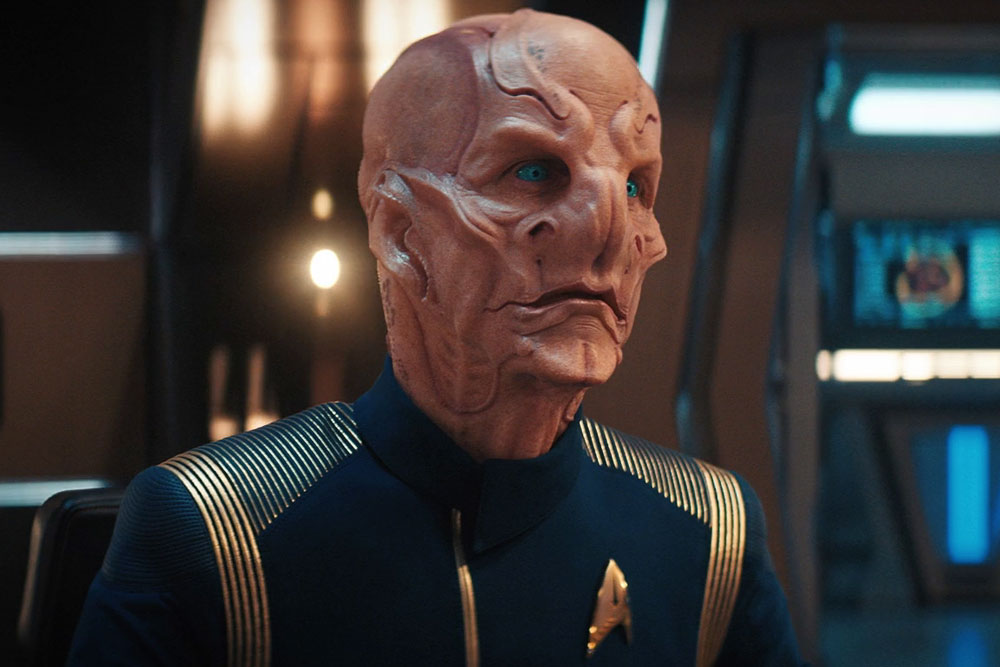
In addition, Book (David Ajala) is introduced to the rest of the Discovery crew as he tags along with Burnham for the trip to Earth, and Ajala continues to shine as the ultra-charismatic Book, who has come across as roguishly sweet in his first two appearances. There is so much more chemistry between Book and Burnham than there ever was between Burnham and Ash Tyler as the show inches towards setting up a will-they-won’t-they romantic subplot for the two characters.
We’re two episodes into their story, and I am already a big fan of this potential couple.
United Earth is an interesting allegory for major Western democracies that have found themselves turning inwards in recent years, believing that prosperity is best served by cutting themselves off to outsiders rather than being part of the global (or in this case, galactic) community. But while that path might lead to prosperity — the few glimpses we get of planet Earth show it to still be a thriving place – it also leads to a society that has become cold and cruel.
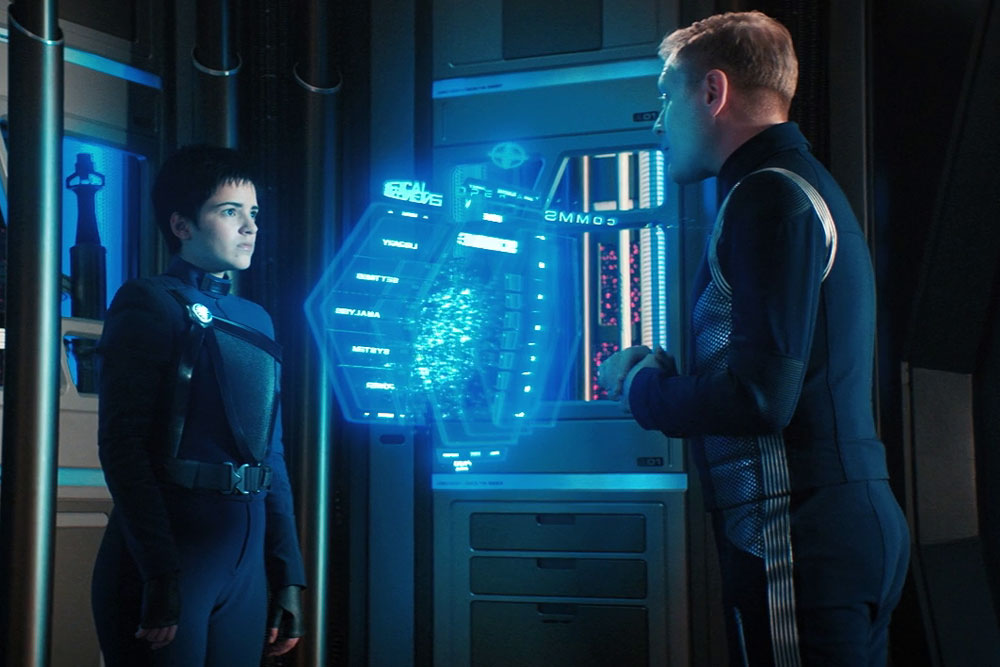
“People of Earth” begins to demonstrate the power and promise that the antique museum science vessel from the 23rd century can bring to the technologically advanced 32nd century. Not just a new form of propulsion to replace warp drive, but the old values of the Federation that large swaths of the galaxy have abandoned since The Burn.
Even in a small interaction between Captain Saru and Captain Ndoya — where Saru insists they communicate with Wen’s raiders rather than comply with standard United Earth protocol to fire first — we can see the differences in values that guide the Federation’s Starfleet versus the United Earth’s Defense Force in stark contrast. And the values of the Federation are ultimately the most effective strategy, with a little bit of 32nd century daring improvisation for good measure.
And after speculating earlier in the episode what from the Earth they remember might have survived the 900 year jump into the future — Tilly wonders whether the Great Pyramids of Giza or the Gateway Arch in St. Louis may have survived — the human crew of the Discovery find meaning not in any of the surviving great landmarks of Earth, but in a tree.
On the grounds of the former Starfleet Academy, the Discovery bridge crew’s human members find a tree from their Academy days still standing 900 years later, a sign that some things that create meaningful connections between people can endure almost indefinitely… and probably thanks to Boothby’s green thumb, too.
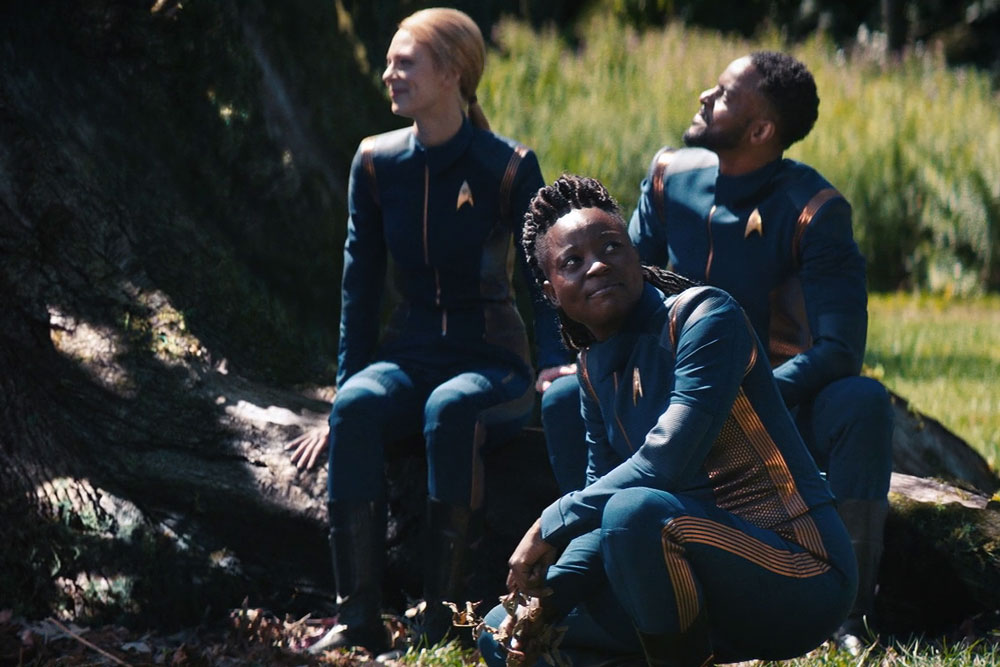
Other Observations
- Burnham tells Saru that she sent a message to Terralysium to try and find her mother — but they responded they had no knowledge of her. Is this tying up a loose end, or setting up a potential mystery to explore later in the series?
- The year 3188 is equivalent to Stardate 865211.3, according to Burnham’s opening log entry.
- Christopher Heyerdahl, who played Wen, is well known to Stargate fans for having played multiple roles in that franchise — most notably Todd the Wraith on Stargate Atlantis — but this is his first role in a Star Trek show.
- Tilly makes a reference to the Gateway Arch in St. Louis, and keeps Gateway Arch snowglobes in her quarters, which makes us think it’s the character’s hometown.
- The much-mentioned Sphere Data from last season’s storyline finally returns as Saru learns about Trill symbionts from the massive alien database; this tracks with 24th century continuity, as the knowledge of symbionts were largely unknown before The Next Generation‘s mid-2360s time period.
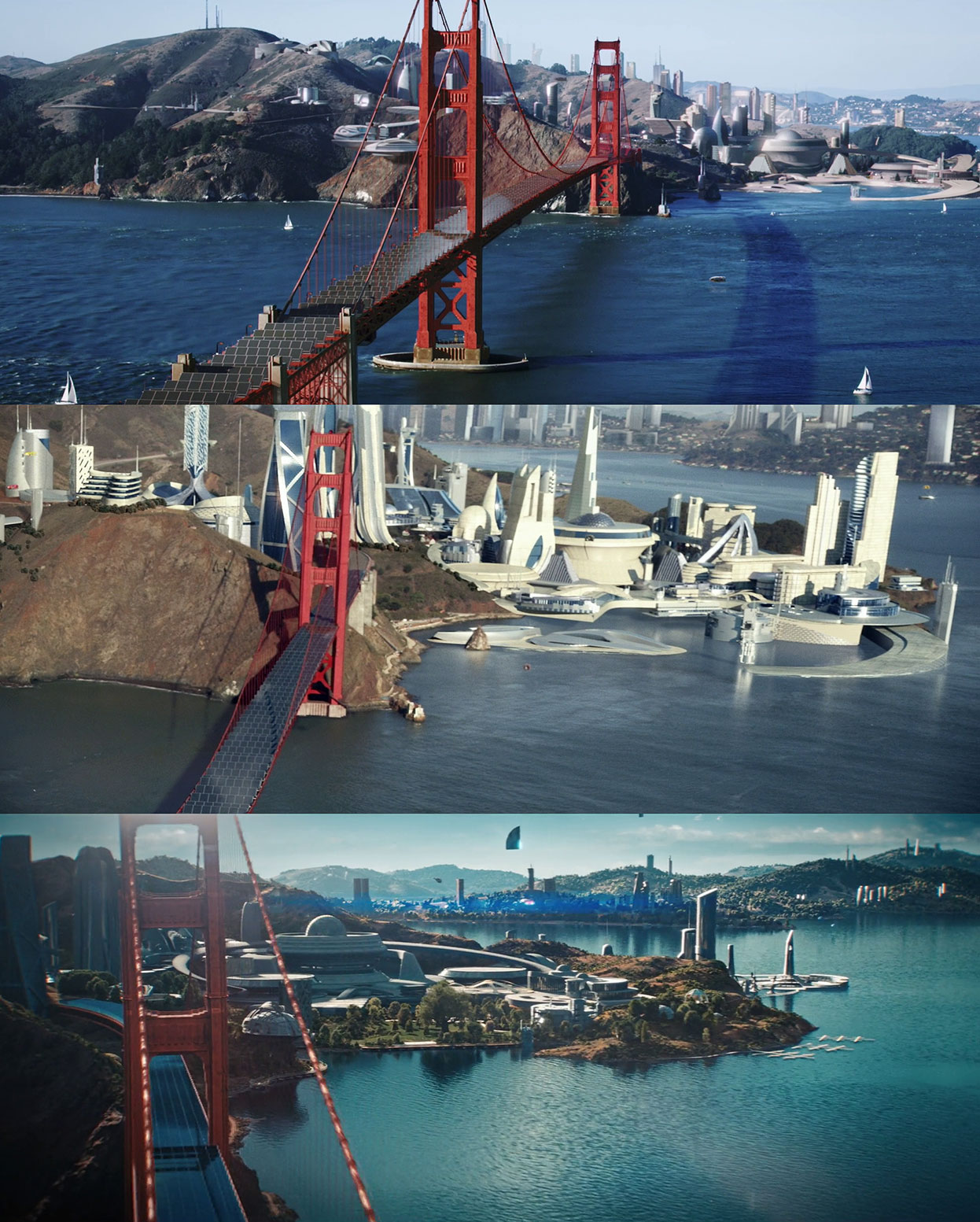
- It’s nice to see that the Golden Gate Bridge survived to 3189, and a San Francisco skyline that looks appropriately advanced from the 23rd and 24th century depictions we’ve seen recently in both Discovery and Picard.
- Discovery carries a lot of dilithium aboard, even after sharing with last week’s Cordian miner crew. It’s unclear whether the chamber that Burnham gets the dilithium from is the ship’s reaction chamber — which were much smaller by the 24th century, which actually would make sense technologically — or if it’s some kind of area where they story dilithium for eventual use in the warp core.

- United Earth might be insular, but it’s not a homo sapiens only club: the United Earth inspectors who board the Discovery include a Tellarite and at least one additional insectoid species.
- Tilly’s wall of Starfleet badges memorializes 24 Discovery crewmembers, including five cadets.
- Discovery’s poor excuses for being a technological relic flying around the 32nd century are going to wear thin quickly, as most of the characters in this episode don’t even believe them. I hope we move on from that quickly.
- “The Federation and Starfleet haven’t been on Earth for a hundred years.” Where they did they go? It looks like this season is going to be about finding out.

Overall, “People of Earth” is a great episode of Star Trek. It has a clear story, some great character moments, and some important messages that resonate back 1,100 years from the 32nd century to the 21st.
If “People of Earth” is a template for the rest of the episodes this season, I will be very pleased.
![]()
Star Trek: Discovery returns for the fourth episode of the season, “Forget Me Not,” on November 5 exclusively on CBS All Access (USA) and CTV Sci Fi Channel (Canada); the episode arrives November 6 on Netflix for all other global regions.
